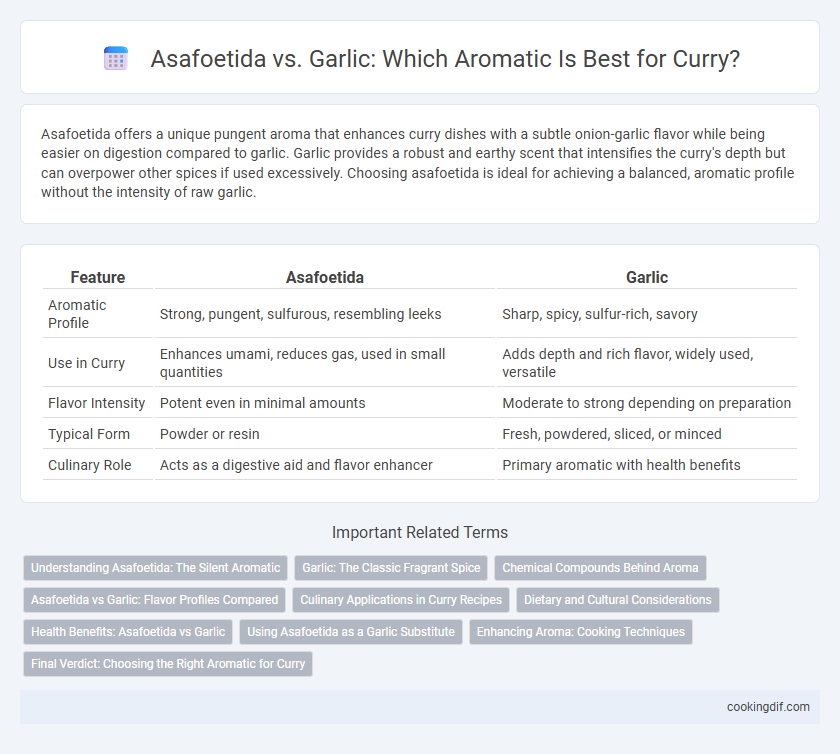Asafoetida offers a unique pungent aroma that enhances curry dishes with a subtle onion-garlic flavor while being easier on digestion compared to garlic. Garlic provides a robust and earthy scent that intensifies the curry's depth but can overpower other spices if used excessively. Choosing asafoetida is ideal for achieving a balanced, aromatic profile without the intensity of raw garlic.
Table of Comparison
| Feature | Asafoetida | Garlic |
|---|---|---|
| Aromatic Profile | Strong, pungent, sulfurous, resembling leeks | Sharp, spicy, sulfur-rich, savory |
| Use in Curry | Enhances umami, reduces gas, used in small quantities | Adds depth and rich flavor, widely used, versatile |
| Flavor Intensity | Potent even in minimal amounts | Moderate to strong depending on preparation |
| Typical Form | Powder or resin | Fresh, powdered, sliced, or minced |
| Culinary Role | Acts as a digestive aid and flavor enhancer | Primary aromatic with health benefits |
Understanding Asafoetida: The Silent Aromatic
Asafoetida, known as the "silent aromatic," offers a unique pungent flavor profile that enhances curry dishes without overpowering other spices, unlike garlic which has a stronger, more dominant aroma. The sulfur compounds in asafoetida release a complex, umami-rich scent when fried in oil, making it an essential ingredient in traditional Indian curries for balancing flavors. Using asafoetida in moderation imparts a subtle earthiness and depth that complements legumes and vegetables, especially where garlic is avoided for dietary or cultural reasons.
Garlic: The Classic Fragrant Spice
Garlic, known scientifically as Allium sativum, offers a rich, pungent aroma that deeply enhances the flavor profile of traditional curries, making it a classic fragrant spice in culinary arts. Unlike asafoetida, which provides a more sulfurous and slightly bitter scent often used as a substitute in certain diets, garlic delivers a sweet, savory aroma that intensifies when sauteed or roasted. Its essential oils, allicin and diallyl disulfide, are responsible for its signature scent, which contributes to the mouth-watering appeal and complexity in spice blends and curry bases.
Chemical Compounds Behind Aroma
Asafoetida's distinctive aroma primarily stems from its sulfur-containing compounds such as disulfides and trisulfides, which release strong, pungent odors when heated. Garlic shares a similar sulfur-rich profile, dominated by allicin and other thiosulfinates that contribute to its sharp, savory scent. The volatile sulfur compounds in both spices are key to their aromatic characteristics, with asafoetida offering a more intense and bitter-smoky nuance compared to garlic's relatively sweeter and fresher fragrance.
Asafoetida vs Garlic: Flavor Profiles Compared
Asafoetida delivers a pungent, slightly bitter aroma that mellows into a smooth, onion-garlic flavor when cooked, enhancing the depth of curries without overwhelming the dish. Garlic, with its sharp, sweet-spicy notes, provides a robust and familiar base taste that intensifies as it cooks, often used as a foundational aromatic in Indian cuisine. Choosing asafoetida over garlic results in a subtler, earthier fragrance that is ideal for those seeking a complex yet gentle flavor profile in curry dishes.
Culinary Applications in Curry Recipes
Asafoetida imparts a pungent, umami-rich aroma that enhances lentil-based curries and vegetarian dishes, offering a subtle onion-garlic flavor without overpowering the dish. Garlic, with its robust and slightly sweet profile, intensifies meaty and tomato-based curry recipes, providing a depth of flavor and richness. Both ingredients serve distinct aromatic roles--asafoetida excels in tempering spices and aiding digestion in legume curries, while garlic adds a bold, savory foundation essential for complex, hearty curry sauces.
Dietary and Cultural Considerations
Asafoetida and garlic both serve as key aromatic ingredients in curry, with distinct dietary and cultural implications. Asafoetida is favored in vegetarian and Jain diets for its pungent flavor without garlic's raw taste, aligning with certain religious restrictions on onion and garlic consumption. Garlic is prized in many global cuisines for its robust aroma and health benefits, but its usage may be limited in some cultural practices due to digestive or spiritual beliefs.
Health Benefits: Asafoetida vs Garlic
Asafoetida contains potent anti-inflammatory and antimicrobial compounds that aid digestion and reduce bloating, making it a valuable spice in traditional medicine. Garlic is rich in allicin, which supports cardiovascular health by lowering blood pressure and cholesterol while also boosting immune function. Both spices offer distinct health benefits, with asafoetida excelling in digestive support and garlic providing comprehensive heart and immune system advantages.
Using Asafoetida as a Garlic Substitute
Asafoetida, known for its pungent aroma, acts as an effective garlic substitute in curry dishes, especially for those with garlic allergies or dietary restrictions. When used in small quantities, it imparts a savory, umami flavor that mimics the depth and warmth of garlic, enhancing the aromatic profile of traditional Indian and Middle Eastern curries. Its potent strength requires careful measurement, typically a pinch, to avoid overpowering the dish while maintaining the intended flavor complexity.
Enhancing Aroma: Cooking Techniques
Asafoetida and garlic provide distinct aromatic profiles crucial for curry preparation, with asafoetida offering a pungent, onion-garlic-like aroma when tempered in hot oil, which intensifies flavor complexity early in cooking. Garlic releases its rich, savory aroma best when sauteed gently to caramelize its sugars, enhancing the depth and sweetness of the curry base. Combining precise cooking techniques for both ingredients maximizes aromatic potential, balancing asafoetida's sharpness with garlic's mellow richness for an optimized sensory experience.
Final Verdict: Choosing the Right Aromatic for Curry
Asafoetida offers a pungent, earthy aroma that enhances curry with a subtle umami depth, ideal for those seeking a strong yet smooth flavor profile without the sharpness of garlic. Garlic provides a bold, robust aroma that brings a familiar warmth and slight sweetness, complementing rich and spicy curry bases effectively. Selecting the right aromatic depends on the desired flavor intensity and dietary preferences, with asafoetida favored in certain vegetarian and Ayurvedic recipes, while garlic remains a versatile staple for diverse curry varieties.
Asafoetida vs Garlic for aromatic Infographic

 cookingdif.com
cookingdif.com